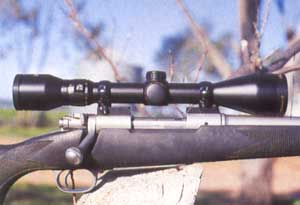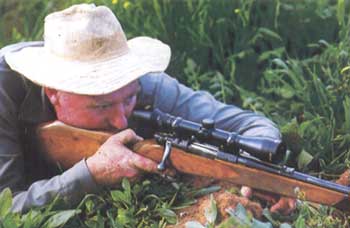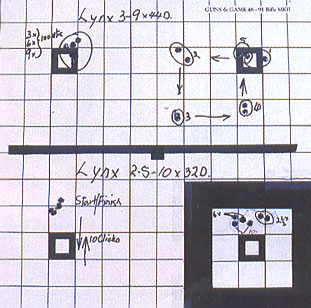


The versatile 3-9x44 Lynx covers the general demands required by a hunting scope today. The field of view is bright and the reticle is sharp and distinct.
New to the Australian Market is the Lynx range of riflescopes, made in Japan to Lynx South Africa specifications. They include useful range of magnifications and tough mono tube construction The Tree Scopes w4e had for review were the 4x40DW "Wide Angle Series", The T3-9x44D "Twilight Series" and the P2.5-10x32D "Professional" Monotube series. All these new scopes are shockproof, waterproof and feature fully coated optics.
The 3-9x44D Scope is probably the one that will appeal to the greatest number of shooters, as it covers the general demands required by a hunting scope today When set on 9x , it proved to be clear, and allowed for precise aiming at all ranges. The field of view is bright and the reticle is distinct and sharp.
The one thing that impressed me with all three Lynx scopes was the almost total lack of parallax. Parallax is a major killer of accuracy in scopes, especially if stock fit is not up to scratch. Most scopes are set to be parallax free at 100-130 meters; this is why target/varmint scopes have parallax adjustments fitted to them, so the setting can be varied.
 |
| The author found the 4x44 a useful and economical hunting scope. |
To test a scope for Parallax, set up a target at 100 meters. A target similar to our GUNS&GAME targets with a known grid pattern is good. Set the rifle in sandbags on a bench or a solid rest so it can't move, with the scope reticle aimed at the target. Now without touching the rifle look through the scope and move your eve 20mm or so side to side and up and down, taking particular note of how much the reticle moved on the target. If the parallax is adjusted correctly, the reticle will stay still on the target, but if the reticle moves, say 25 –40mm on the target you have a parallax problem. If the reticle only moves 5mm, your problem is negligible, As a general rule of thumb, the higher the magnification, the harder it is it set parallax correctly.
That is why a fixed 6x or 8x scope is not really a good idea for a .22 rimfire. The parallax is set at 120 meters but 98% of rimfire shooting is done at 25m to 75m, where these scopes have parallax errors. The reason stock fit is so critical will become apparent when you do the parallax test. Obviously if you can place your eye in exactly the same position behind the scope when you take each shot, then parallax ceases to be an issue.
Back to the 3-9x44D… On 3x, you have a generous 14 meter field of view at 100 meters for running game. I must admit, I didn't use the 3-9 on its lowest power, except on the target, to check whether the point of aim changed as the power was changed. I am please to report that a 6-shot group at 100 meters measured 22.8mm (.9”), (2 shots on each power setting, 3x 6x, and 9x) which I think is pretty good considering on a 6x and especially 3x, you are only guessing where the aiming point is. The 3-9 also tracked around the target very well. I was able to directly compare optics with a 3-9x50 Vari X 2 Leopold, and while the Leopold had a very slight edge in brightness because of the bigger objective, the Lynx had a slightly larger field of view, and the Lynx retile was easier to see at dusk, as it was a little heavier.
The 4x40DW wide Angle series is at the entry level of the range in the Lynx line up , but don’t be put off by that. The windage and elevation graduation is pretty close to spot on. For field-testing I took it spotlighting and shot some rabbit. Head-shooting rabbits out to 120 meters was no trouble with the 4x. As with the other two Lynx scopes tested, this one exhibited almost zero parallax. Optically it is right up there with my 4x Kahles, bright and sharp right out to the edge of the field of view. The reticle is defined and easy to see. This scope would be an excellent accompaniment for the .22 rimfire.
The 2.5-10x32D is very compact scope with a 32mm objective and 39mm ocular housing, combined with an overall length of 275mm. The Tube is still plenty long enough to mount on a .30-06 length action. This scope has a Monotube construction. Machined from aircraft grade aluminium.
A real surprise packet, the 2.5-10x32D featured extremely clear and bright optics. Because of its very small lenses field of view is smaller than other scopes with larger lenses and tube systems.
Testing the 2.5-10x32D, it performed well as can be seen from the target while sighting this scope in, I did shoot a neat 3 shoot clover group that ran just over 2”. I tried this scope down and up to check the turret adjustment accuracy. The start-finish group was just over .52”, so I really didn't need to go further.
To Check the accuracy if this scope at different powers, I used a large aiming point becasue at 2.5x, the 1" square aiming point can't be seen behind the crosshairs. Results were perfect on 6x and 10x and the point of aim moved only slightly at 2.5x, where it is of least concern.
As This scope is designed to go on a hunting rifle, I mounted it on a Browning .270 Win, After Sighting in I ran the power change check and achieved almost identical results. Field-testing consisted of a nights pro shooting. No mean feat with a .270 Win (my usual gun is a.22-250 or Smaller) as all animals must be a head shot. The little scope preformed perfectly. I Changed the power back to 2.5x to shoot a couple of rabbits at 55-70 meter and the shot a couple of larger animals as 4x out to 130 meters, all with 100% success.
 |
| Target showing bullet impact at different power settings, and tracking ability of the scopes. |
Before I got it Breil Jackson mounted this scope on his new Winchester Model 70 Classic .300 Weatherby Magnum and did a lot of load development work. Even a diet of full power loads presented no problem for the Lynx. He also placed the scope in warm water to test for nitrogen leaks – After 20 minutes none appeared, nor did any water enter the scope, so it would appear the seals are very good.
Breil was also very impressed with the eye relief of this scope (more than 75mm.even on 10 power) as it meant the scope could be mounted on a heavy recoiling gun (like the .300 Magnum) , without fear of being hit by the scope. Really our only criticism of this scope is that the ocular lens is quite close to the outside of the housing where it is less protected than if it were further in.
In conclusion this little scope intrigued both the editor and myself, because of its compact size and the potential for super low mounting on a hunting rifle to ensure the good stock fit I spoke of earlier. There is also the bonus of making the rifle more streamlined. When all our testing was finished, the editor bought this scope and mounted it back on his Winchester .300 Weatherby Magnum. The 2.5-10x32D scope is the top of the line Professional series from Lynx and is well worth a good hard look.
Finally I had a visit from four local Kangaroo shooters and all were suitably impressed with all the Lynx scopes and how beautifully clear they were. Three of the four shoot 8x Kahles and the forth one shoots a world class Tasco.
I look forward to seeing some more of the Lynx line especially the Professional Monotube series in fixed power. if the 2.5-10X32 is anything to go by they look like great little scopes at a very reasonable price!